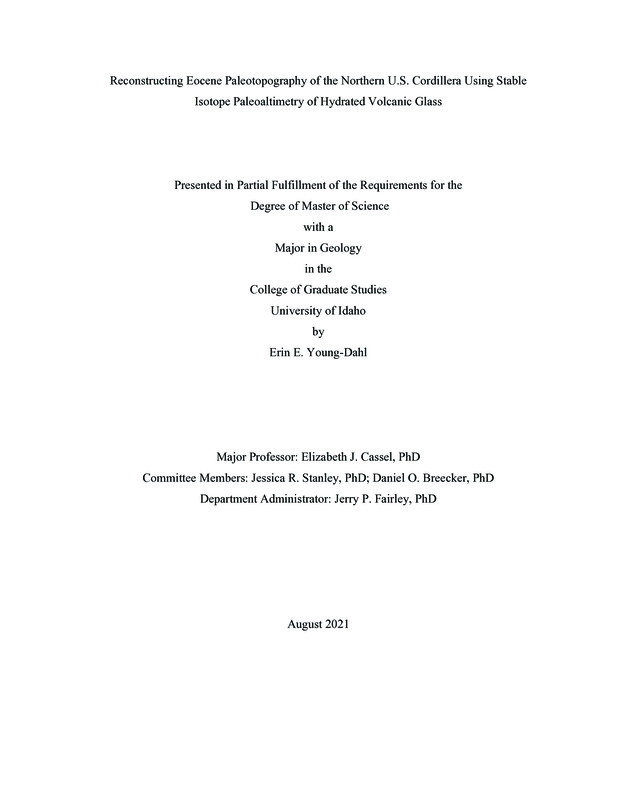Reconstructing Eocene Paleotopography of the Northern U.S. Cordillera Using Stable Isotope Paleoaltimetry of Hydrated Volcanic Glass
Young-Dahl, Erin Elisabeth. (2021-08). Reconstructing Eocene Paleotopography of the Northern U.S. Cordillera Using Stable Isotope Paleoaltimetry of Hydrated Volcanic Glass. Theses and Dissertations Collection, University of Idaho Library Digital Collections. https://www.lib.uidaho.edu/digital/etd/items/youngdahl_idaho_0089n_12214.html
- Title:
- Reconstructing Eocene Paleotopography of the Northern U.S. Cordillera Using Stable Isotope Paleoaltimetry of Hydrated Volcanic Glass
- Author:
- Young-Dahl, Erin Elisabeth
- ORCID:
- 0000-0002-5486-8396
- Date:
- 2021-08
- Embargo Remove Date:
- 2022-09-01
- Keywords:
- Farallon slab rollback paleotopography stable isotope paleoaltimetry TREE volcanic glass
- Program:
- Geology
- Subject Category:
- Geology; Geochemistry
- Abstract:
-
Topography controls regional drainage patterns, sediment transport, resource accumulation, climate, and atmospheric circulation. In turn, topography is controlled by plate tectonic forces and crust and mantle processes, such as compression, delamination, extension, heating, and magmatism. In studying the surface record, researchers can estimate past elevations, the timing of surface uplift or lowering, and the regional extent of highlands, which are needed to characterize the lithospheric processes and conditions responsible for changes in surface topography. In the complex tectonic setting of the northwestern United States, paleoelevation records can help interpret the timing and processes behind Rocky Mountain orogenesis. During the Eocene (ca. 56-34 Ma), the northern U.S. Cordillera experienced a shift from compression and Laramide-style thrusting to extension, recorded in extensional basin formation, exhumation of metamorphic core complexes, and southwestward migration of magmatic activity, accompanying surface uplift in the fold-thrust belt and elevated Sevier hinterland. However, researchers disagree on the extent, lifespan, and elevation of this highland or how the region evolved into the modern Rocky Mountains. I used stable isotope paleoaltimetry of Eocene-age hydrated volcanic glass shards collected along a longitudinal transect from the western paleoshoreline to the Great Plains to determine estimates and locations of high topography associated with this period of Rocky Mountain surface uplift and lowering. Volcanic glass acts as a proxy for the long-term average δD value of paleo-meteoric water at the time of glass deposition. I analyzed ancient meteoric water preserved in volcanic glass samples of known or inferred age across the study area to create Paleogene paleotopographic profiles across the range. Glass hydrogen isotopic ratio (δDglass) values from samples from fluvial and alluvial sections range from -223.6‰ ± 2.4‰ to -89.0‰ ± 6.9‰VSMOW. The most D-depleted samples are consistently found in west-central and southwest Montana, and yield modeled paleoelevations of 4640 +720/-440 m in the early Eocene down to 3400 +520/-540 m in the late Eocene - Oligocene. From these data, I find that topography was long-standing throughout the Paleogene, despite surface lowering by ~1200 m by the Oligocene. Because high Eocene pCO2 would have reduced isotopic lapse rates, these values are minimum paleoelevation estimates. A combination of crustal thickening from recent shortening and thermal/geodynamic effects from Farallon slab rollback, delamination, and/or high heat flow from regional volcanic activity are responsible for the development of Paleogene northern U.S. Cordilleran paleo-highs.
- Description:
- masters, M.S., Geology -- University of Idaho - College of Graduate Studies, 2021-08
- Major Professor:
- Cassel, Elizabeth
- Committee:
- Stanley, Jessica; Breecker, Daniel
- Defense Date:
- 2021-08
- Identifier:
- YoungDahl_idaho_0089N_12214
- Type:
- Text
- Format Original:
- Format:
- application/pdf
- Rights:
- In Copyright - Educational Use Permitted. For more information, please contact University of Idaho Library Special Collections and Archives Department at libspec@uidaho.edu.
- Standardized Rights:
- http://rightsstatements.org/vocab/InC-EDU/1.0/

